Description
“Uniquely evocative… the kicker is the bank of ten harmonically pitched sine waves and their pan / level-modulating Uncertainty knob. Start mixing these in with the three main sounds and things get really weird – in a good way“– Computer Music magazine
![]()
![]()
Cloud Chamber takes its inspiration from the raw material of all sounds: moving air. With both acoustic and electronic components at its heart, Cloud Chamber excels at creating strange, ethereal tones and textures with the sonic fingerprint of acoustic sources; “unreal” instruments that nevertheless sound like they should be real; and complex, varying, evolving soundscapes that conjure up steampunk-style futures, windy mountain peaks, industrial piston chambers, sussurating cave mouths, and a thousand other uniquely characterful locations. Whether you want a hissing pad from the Victorian steam age for an electronic track or a convincing Troll flute hewn from a solid tree-trunk for your soundtrack, Cloud Chamber makes dialling up wind sounds a breeze! (Yeah. We actually went there.)
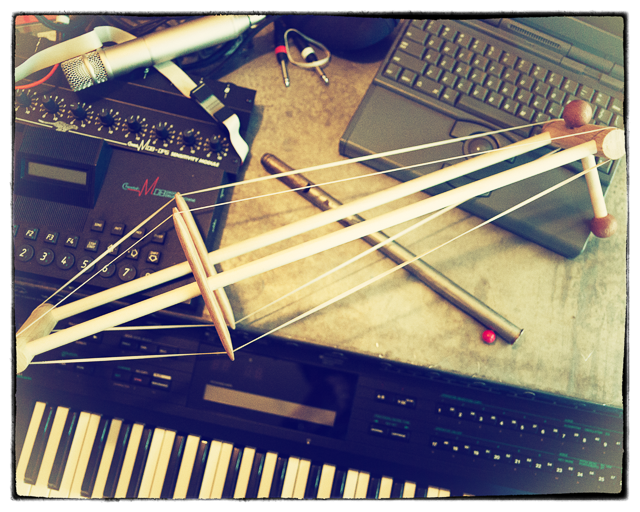 We started with a strange collection of sound-producing instruments and vessels all of which rely on basic air vibration to yield up their noises, and recorded these in three sections which form the main textural controls of Cloud Chamber. Pipes is sampled from vintage swannee whistles and penny whistles, and provides a high-pitched descant sound with a fairly clean attack – just a hint of overblown harmonics. Flasks comes from a series of differently-sized laboratory bottles and retorts, some of which were very big and required all of Mongo’s lung-pressure to blow convincingly. These are mid-range sounds that have a very pronounced white noise “chiff” in the attack. Finally, over on the right-hand end, there is the Rotors section, which was sampled from an amazing twin-tone bullroarer-style “wind wand” – a tensioned apparatus of bands and sticks which is whirled through the air in a circular fashion, making the strings and bands vibrate to produce a cyclic, complex tone. This has a very slow attack (as the apparatus spins up to speed) and a pronounced tremolo effect.
We started with a strange collection of sound-producing instruments and vessels all of which rely on basic air vibration to yield up their noises, and recorded these in three sections which form the main textural controls of Cloud Chamber. Pipes is sampled from vintage swannee whistles and penny whistles, and provides a high-pitched descant sound with a fairly clean attack – just a hint of overblown harmonics. Flasks comes from a series of differently-sized laboratory bottles and retorts, some of which were very big and required all of Mongo’s lung-pressure to blow convincingly. These are mid-range sounds that have a very pronounced white noise “chiff” in the attack. Finally, over on the right-hand end, there is the Rotors section, which was sampled from an amazing twin-tone bullroarer-style “wind wand” – a tensioned apparatus of bands and sticks which is whirled through the air in a circular fashion, making the strings and bands vibrate to produce a cyclic, complex tone. This has a very slow attack (as the apparatus spins up to speed) and a pronounced tremolo effect.
All three primary sounds can be blended to taste, and can have their characterful attack portion switched on or off via the SSA (Skip Sample Attack) switch. Engaging this lops off the first half-second or so of the sound, giving an instant, clean start to the sound, without the overblow, chiff or ramp-up. This is great for creating more abstract, less obviously acoustic tones. Each primary sound also has an ADSR envelope and a fully variable tremolo control which can be set super-slow for strange, eerie periodic fluctuations, or super-fast for metallic, almost ring-mod-style distortion. Finally, each primary panel has a pitch envelope which can swoop down to pitch or up to pitch at variable speeds, and decay off-pitch again at the end of the sound; that’s the three-slider control with the arrows in the bottom of each pane, and it’s useful either for simulating the acoustic pitch swoop that many wind instruments exhibit, or for dialling in extreme, alien pitch drifts and special effects.
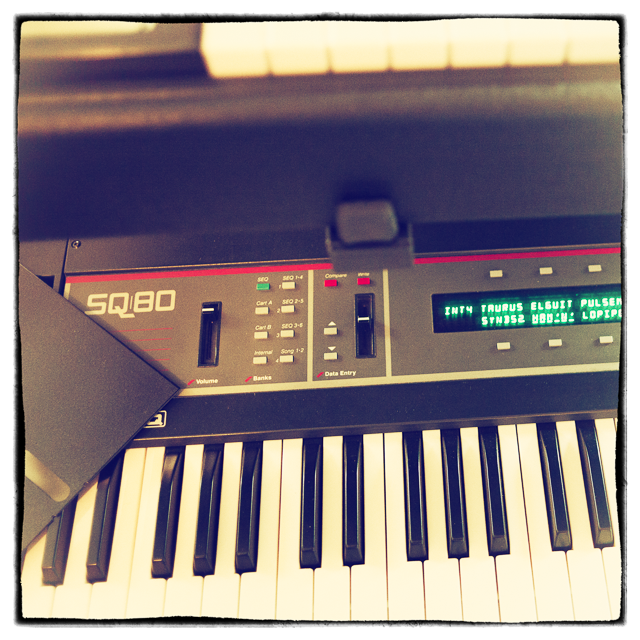 But that’s not all. The central section houses something of a secret weapon: a Sine bank of ten sine waves, pitched to the harmonic series. These can be dialled up in varying proportions and are under the control of their own ADSR envelope. Dialling up odd, unusual harmonics higher up in the series can add a really spooky, unearthly tone to the base waves, especially if you fade them in gradually. Or you can graft an acoustic attack from one of the primary sounds onto a sustain synthesised from the Sine Bank. In fact, the Sine Bank is where you can really take the character of your Cloud Chamber sounds away from the acoustic and into pure synth territory. We auditioned all kinds of sine waves for this important role and the ones we chose come from the 8-bit DCOs of the Ensoniq SQ80. We chose these over perfect, pure analogue sines because the aliasing and digital distortion imparted by that crude low bit-depth adds a lot of high-frequency “air” and interest that we simply didn’t get with analogue waves; so these sines really add to the airiness and character of the instrument.
But that’s not all. The central section houses something of a secret weapon: a Sine bank of ten sine waves, pitched to the harmonic series. These can be dialled up in varying proportions and are under the control of their own ADSR envelope. Dialling up odd, unusual harmonics higher up in the series can add a really spooky, unearthly tone to the base waves, especially if you fade them in gradually. Or you can graft an acoustic attack from one of the primary sounds onto a sustain synthesised from the Sine Bank. In fact, the Sine Bank is where you can really take the character of your Cloud Chamber sounds away from the acoustic and into pure synth territory. We auditioned all kinds of sine waves for this important role and the ones we chose come from the 8-bit DCOs of the Ensoniq SQ80. We chose these over perfect, pure analogue sines because the aliasing and digital distortion imparted by that crude low bit-depth adds a lot of high-frequency “air” and interest that we simply didn’t get with analogue waves; so these sines really add to the airiness and character of the instrument.
They also give the filters something to bite into. At the bottom of the central panel we have high- and low-pass filters, with the low-pass switchable between a very gentle, smooth 1-pole (6db/octave) model for subtly sculpting the sound, and a chewy Moog-style 4-pole (24db/octave) ladder filter with resonance. The low-pass has its own cutoff envelope, of course, for sweeps and blips or for longer, smoother tonal transitions.
There are two last controls worth pointing out: the Uncertainty knob introduces random, unpredictable level and pan changes to all of the active waves in the Sine Bank, creating drifting clouds of sine waves that fade in and out and blur and shimmer through the stereo field, adding a lot of movement to the sound. And the Glitch control you may know by now: it randomises all of the settings, but in a musically sensible way, so as to give you new starting points for patches with a single mouse-click. It’s our one-stop shop for instant inspiration, and you can click it whenever you want a surprise 🙂
The rear Effects panel has comprehensive controls for Delay, Reverb, Leslie Rotary Speaker and Amp cabinet simulation, all of which allow you to add further colour and character to the sound: the amp cabs in particular let you stamp interesting limited frequency responses across the whole sound, for strange, compressed, contained tones that often sit better in the mix.
Cloud Chamber is very deliberately not a recreation of an existing instrument: it’s not a whistle, or a blown bottle, or a bullroarer. Instead, it’s a toolkit synthesiser for creating all kinds of convincing acoustic instruments and leaking, hissing steampunky machines, as well as weird and unlikely electronic sounds which nevertheless have an acoustic vibrancy to them. It can take you wherever the wind blows…
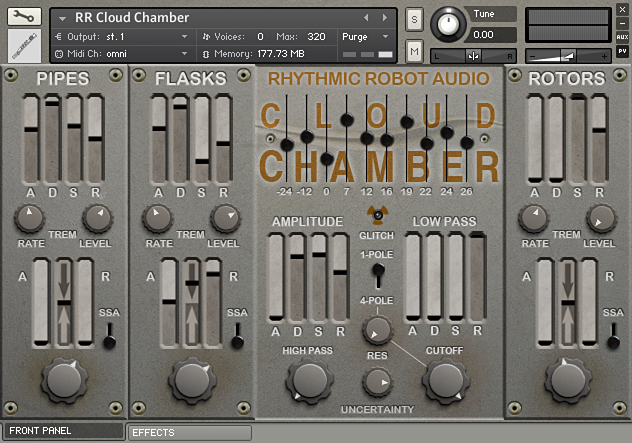
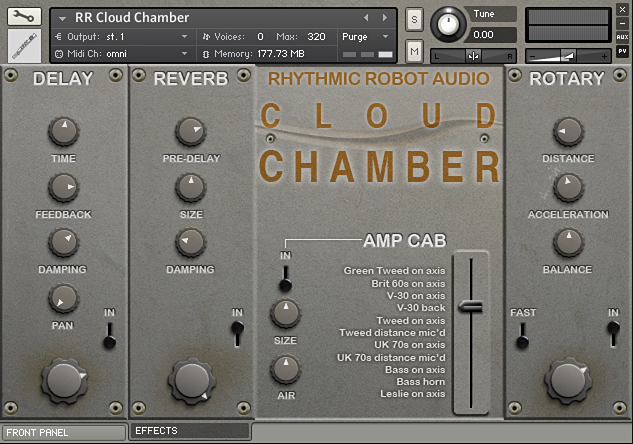
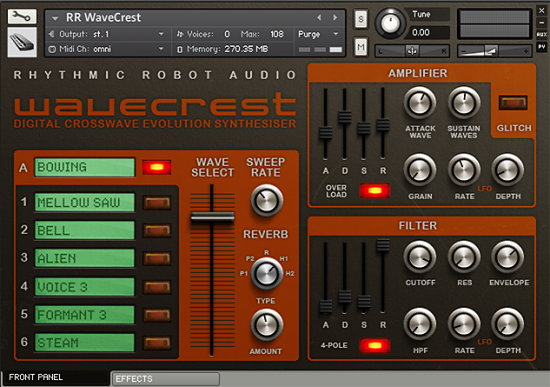
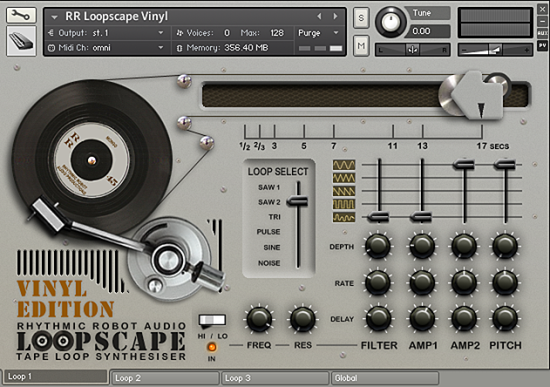
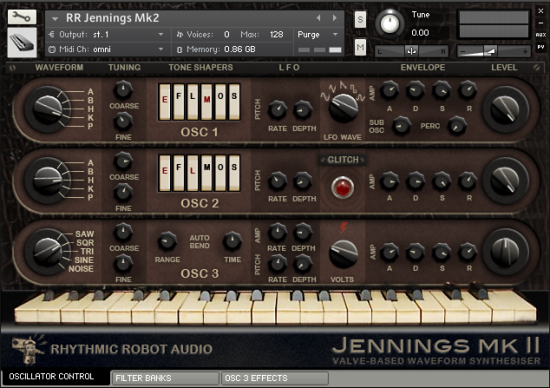
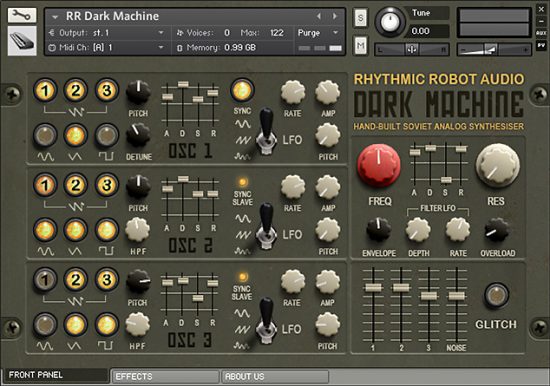
JAMES (verified owner) –
This is a weird one (even for RR…hurdy-gurdy synth – WTF?). It is one of wilder sources of harmonic information they have used to create a “synth”. It is very sensitive to parameter changes and playing velocity. It requires a little more work than some to get great sounds, but when it’s great it’s completely unique and compelling. If you’re like me and enjoy the darker side of sounds and this comes off as a little lighter and “whimsical”, try playing the sounds in the lower ranges of your keyboard and you will hear a completely different side of this instrument. Love the “glitch” button as always!
mightbeacoolusername (verified owner) –
I’m a little scared by this one some times, it does things I never even considered and conjures images of things long lost. Though Cloud Chamber can do melodic and harmonic material very well with a bit of taming, for my money it really begs to be let loose into ornamental and atmospheric roles, where its evocative talents can best be put to use. It’s rather like standing at the edge of a forest, deep and dark, and hearing something you never have before from within. You don’t want to leave yet, and you don’t feel comfortable pressing the matter, so you stand and listen, and let your imagination attach a source to the sound. It’s a powerful and unique tool.
aqaraza (verified owner) –
Cloud Chamber is another of the instruments I knew I wanted from the very beginning, or at least from the first time I heard it. The depth of organic sound it can produce is impressive. Several of the presets are structured in such a way that by pressing a new ken lightly, you can subtly ease in an entirely new harmonic. It is a sound I know I will return to again and again in particular cases where subtlety of voice or overtone is called for.
There are a handful of things that keep this instrument from its full potential, I feel. The first is that Velocity response seems somewhat limited, in comparison to a couple of the Velocity Retrofit instruments I’ve tried most recently. Put simply, Velocity here seems to react as a simple reign on initial volume, where-as there are enough other parameters that it could so easily be tied as well to one of those, enriching the breathy light notes. Th fact, “breathy”: The instrument calls out for this! Maybe a Velocity Futrofit.
The second is the absence of a glitch/rnd button. I know I am a broken record on this, but there are so few instrument makers who even bother to attempt this, and RR does it so well in the ones it does, that I crave it in all of their instruments.
But even so, I love Cloud Chamber. And if you’ve read this far and reacted with a nod to anything I’ve said, you will also.
Asterios (verified owner) –
Cloud Chamber is a unique instrument, full of ethereal-windy-atmospheric-strange sounds!! It’s my latest addition in my R.R. amazing collection and I think it will be my favorite one!! Weird and wonderful!! I love the sounds that come out of Cloud Chamber and I also love the effects & randomization button!! Mongo and the professor did it again!! Very well done!! 🙂
michael.topic (verified owner) –
I love the sounds this instrument makes because they are ethereal and airy. When you want to add a contrast to heavier passages, in your music, these gentle, unassuming sounds can act as an aural sorbet, cleansing the sonic palette. Like most of the Rhythmic Robot products I find most interesting, the effects are subtle. There is always something other than the chromatic note in your melody going on, which tends to make you pay more attention to the music, I find. There are some very catchy sounds in this collection.
salohcin894 (verified owner) –
Fantastically organic sound! Perfect for scoring.
At first I was frustrated because I couldn’t figure out where all the synth voices were coming from and I just wanted the sounds of the pipes and flasks. Turns out I mistook the middle control panel as an eq, when in reality all the values represent an individual voice and their volume pitched in relation to the note you play. That’s probably what I get for skipping the instructions out of excitement, but none the less, my frustration quickly turned to joy. How varied and rich, but also simple and effective! The whole line up for rhythmic robots instruments could be described that way. Simple and effective.
The effects are also a welcome addition. Usually I’m wary of onboard effects, rather opting to use my own, but just turning one dial changed the sound in such an incredible way. The randomization button on the front is also greatly appreciated. Not enough instruments have that and it’s always such a good jumping off point when creating your own patches. Great sounds as always!
brianedwardpoe (verified owner) –
“If this is the stuff dreams are made of
No wonder I feel like I’m floating on air”
Chris (verified owner) –
Do you want spooky, strange, weird, wonky and wonderful? Then look no further.
Mike McKew (verified owner) –
Very awesome instrument! Definitely makes it easy to get some wild sounds that really have some exceptional quality. Very atmospheric and will be a staple for me moving forward.
Julian (verified owner) –
Once again Rhythmic Robot makes an incredible, unique sounding VI. Like all their products, you feel as if you’re tweaking software to imitate something that exists, but rather playing with a new and inspiring instrument. That’s the highest compliment I can give you any plugin, that I forget I’m using a computer and feel like I’m creating. Well done. Again.
James –
Harry Partch would be proud! Amazing atmospheres and soundscapes can easily be found with a push of the glitch button. Alien pan flute ensembles, mellotronic organs and swirling organopads are all part of this instrument’s very unique orbit.
Scott –
A brilliantly inspired piece of weirdness for a stupidly low price. I’ve spent hours messing about with the strange sounds you can get out of this. Think etheral atmospherics rather than melodies. (But not soothing new-age atmospherics. Not harsh or industrial either. They are their own thing, and there’s nothing else much like them around.)
asc (verified owner) –
You can get some surprising sounds out of this instrument. Love the atmospheres you can create with it. And pretty affordable for its range and quality.
Dan –
More than just the best Clanger simulator on the planet, this thing makes windy noises you’d spend possibly months trying to create on another instrument.
Five Stars!
Kitusai –
Mongo (and the professor – or maybe the opposite?) create really strange instruments! I own for now Loopscape and Cloud Chamber. With this review I’ll also own the Seinfeld bass for free, thanks to them 😉
Cloud Chamber is my prefered one especially with this randomize function that makes it so impredictable and inspiring.
I wouldn’t say that those instruments are coming from the ancient times through modern computers. I consider them as creative newbie carrying old times under the arm as we carry bread ‘baguettes’ this way by here (we are making music in our sheepfold in our mysterious wild Pyrénées mountains, for more ethnology please take a look and throw an ear at http://www.kitusai.com)
As in Cloud Chamber, the wind is blowing around our snowy and beary summits. Sometimes in our heads as well.
Weird was supposed to meet weird. It’s done.